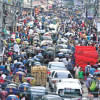Utilise the demographic dividend as an asset, before it becomes a liability

Bangladesh has a predominantly youthful demographic. Our population is close to 170 million, according to the post-enumeration check of the government's preliminary survey conducted by the Bangladesh Institute of Development Studies (BIDS), with about two-thirds falling within the working-age group of 15-64 years. The remaining population is divided, with nearly 29 percent under 15 and approximately six percent above 65. This favourable age structure offers significant potential for driving our economic growth, known as the demographic dividend, which started in 2007 and is projected to continue until 2040.
To fully benefit from its demographic dividend, Bangladesh needs to prioritise improvement in education, healthcare and job opportunities for the youth, while ensuring social welfare and healthcare for the growing elderly population. Substantial changes in these areas are still lacking, posing a risk of losing this once-in-a-lifetime opportunity. This underscores the relevance of the Malthusian population theory, which warns of economic and social challenges when a rapidly growing population is not effectively managed.
Bangladesh has made remarkable progress in establishing a comprehensive education infrastructure to meet the needs of its youthful population, comprising primary schools, colleges and universities. This development has resulted in a significant rise in enrolment rates at primary and secondary levels. The higher education sector has witnessed an even more remarkable expansion, with an annual influx of approximately five million students, representing a marked surge compared to the mere 31,000 tertiary-level students in 1972. Enrolment in vocational and technical education sectors has also increased, although not to the same extent as the tertiary level.
In order to fully leverage the potential of its growing student population, the country must prioritise education quality alongside infrastructure development. Unfortunately, this crucial focus on quality is often neglected at all levels of education, while prioritising visible developments such as infrastructure or the graduation of students with good GPA scores.
This is evident in the surge of students achieving high GPA scores in secondary and higher secondary levels, setting new records each year. For instance, in 2022, nearly 160,000 students attained GPA 5 at the HSC level, compared to only 20 in 2003 when the grading system was introduced. However, this surge in GPAs does not reflect the overall quality of Bangladesh's education system, which continues to lag behind other countries and its own records of previous years. Consequently, the tertiary education system is now accepting students of lower calibre compared to the previous years, exacerbating the existing challenges at this level.
Bangladesh still relies on foreign manpower to implement large-scale projects, instead of having a sufficient number of relevant graduates. This is in addition to the limited job opportunities available. Additionally, the allure of job security in the public sector has made it an attractive option for tertiary-level students. The harsh reality is that a significant portion of university-level students view their education solely as a means to qualify for job exams, undermining their educational growth and skills development.
At least 72 percent of tertiary-level students are enrolled at affiliated colleges of the National University, where the quality of education is highly questionable due to limited research capabilities, inadequate infrastructure, high student-to-teacher ratios, and a shortage of qualified instructors. Almost all public and private universities in Bangladesh, particularly newly established district-level ones, face similar challenges. Moreover, they have mostly failed to align their curricula with market demands and establish strong industry-academia connections. As a result, the overall quality of tertiary education remains poor, despite an increase in students achieving good CGPA scores. Consequently, the country is experiencing rising unemployment, accompanied by an increasing number of foreign employers.
Bangladesh still relies on foreign manpower to implement large-scale projects, instead of having a sufficient number of relevant graduates. This is in addition to the limited job opportunities available. Additionally, the allure of job security in the public sector has made it an attractive option for tertiary-level students. The harsh reality is that a significant portion of university-level students view their education solely as a means to qualify for job exams, undermining their educational growth and skills development.
The country's health sector also faces numerous challenges, including detrimental health issues and suboptimal outcomes that hinder economic growth and development. For instance, there is still a lack of universal progress in women's healthcare, who make up half of the workforce, due to societal and healthcare facility challenges. Prevalence of early marriage also remains high, as around 50 percent of women aged 20-24 years reported being married before the age of 18 in the Bangladesh Demographic Health Survey 2022. Ensuring a safe work environment for women and reducing violence against them are ongoing concerns. Utilisation of maternal healthcare services with continuity remains low. Additionally, the country grapples with elevated rates of under-nutrition across different age groups. These circumstances not only limit employment opportunities and educational attainment, but also increase the risks of life-threatening complications and the burden of disease.
Furthermore, the healthcare system in the country inadequately addresses rising health challenges, especially for the working population. For instance, the prevalence of non-communicable diseases such as diabetes and hypertension is surging, affecting young adults and middle-aged individuals. However, the healthcare system lacks sufficient initiatives to tackle these issues. Many cases go undetected. This lack of emphasis on the ongoing and rising health challenges not only hampers workforce participation, but also increases the disease burden on the working-age population.
Half of Bangladesh's demographic dividend period has passed. Yet, the country has made limited efforts to fully utilise the potential opportunities arising from this shift. It is crucial for the country to focus on actively and effectively exploiting the remaining opportunities now and in the future. Prioritising educational quality and ensuring universal healthcare coverage instead of solely focusing on infrastructure are essential. Failure to do so could transform this demographic shift from an asset to a liability when the once-in-a-lifetime window of the demographic dividend period closes.
Dr Md Nuruzzaman Khan is a public health expert and assistant professor of population science at Jatiya Kabi Kazi Nazrul Islam University.


 For all latest news, follow The Daily Star's Google News channel.
For all latest news, follow The Daily Star's Google News channel. 











Comments